Business Communication Report: Models, Systems, and Processes Analysis
VerifiedAdded on 2020/07/23
|9
|2556
|45
Report
AI Summary
This report provides a comprehensive analysis of business communication within a professional environment. It begins by exploring the needs of both internal and external stakeholders, emphasizing the importance of effective communication for employee participation and successful project teams. The report then delves into various communication models, including linear, transactional, and constructionist approaches, and evaluates the effectiveness of different communication systems. Factors influencing the choice of communication media are discussed, along with the significance of grammar, sentence structure, and punctuation in business communications. The report also covers planning and structuring communication media, overcoming communication barriers, and the use of communication theories and body language. Furthermore, it examines proofreading techniques for business communication, the purpose and audience of information, and the appropriate use of communication media for different audiences. The report also explores the use of correct language, body language, and tone of voice in verbal communication, as well as the importance of clarifying information and responding to situations in accordance with organizational policies and standards. The report concludes with a discussion of how to meet deadlines and maintain timeliness in business communication.
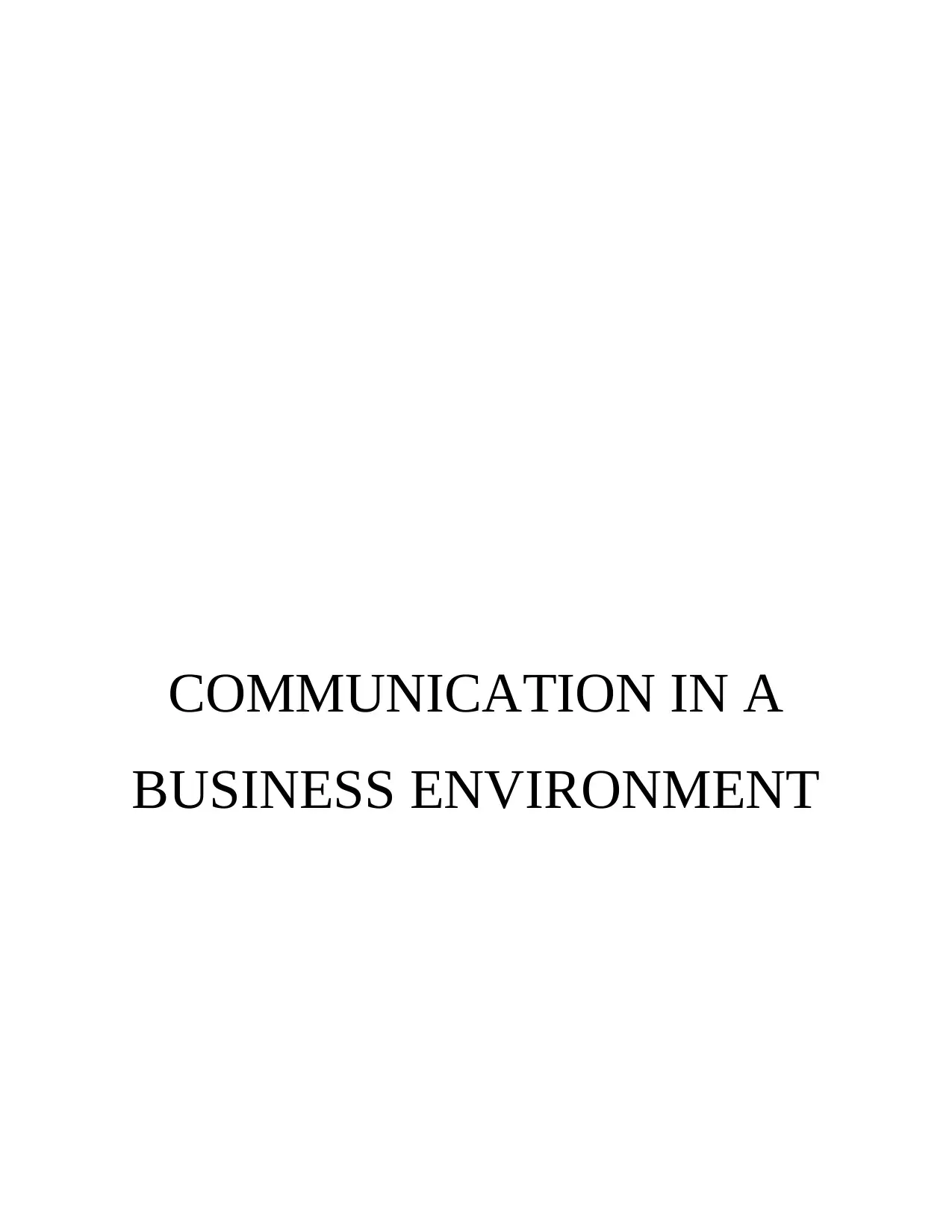
COMMUNICATION IN A
BUSINESS ENVIRONMENT
BUSINESS ENVIRONMENT
Paraphrase This Document
Need a fresh take? Get an instant paraphrase of this document with our AI Paraphraser
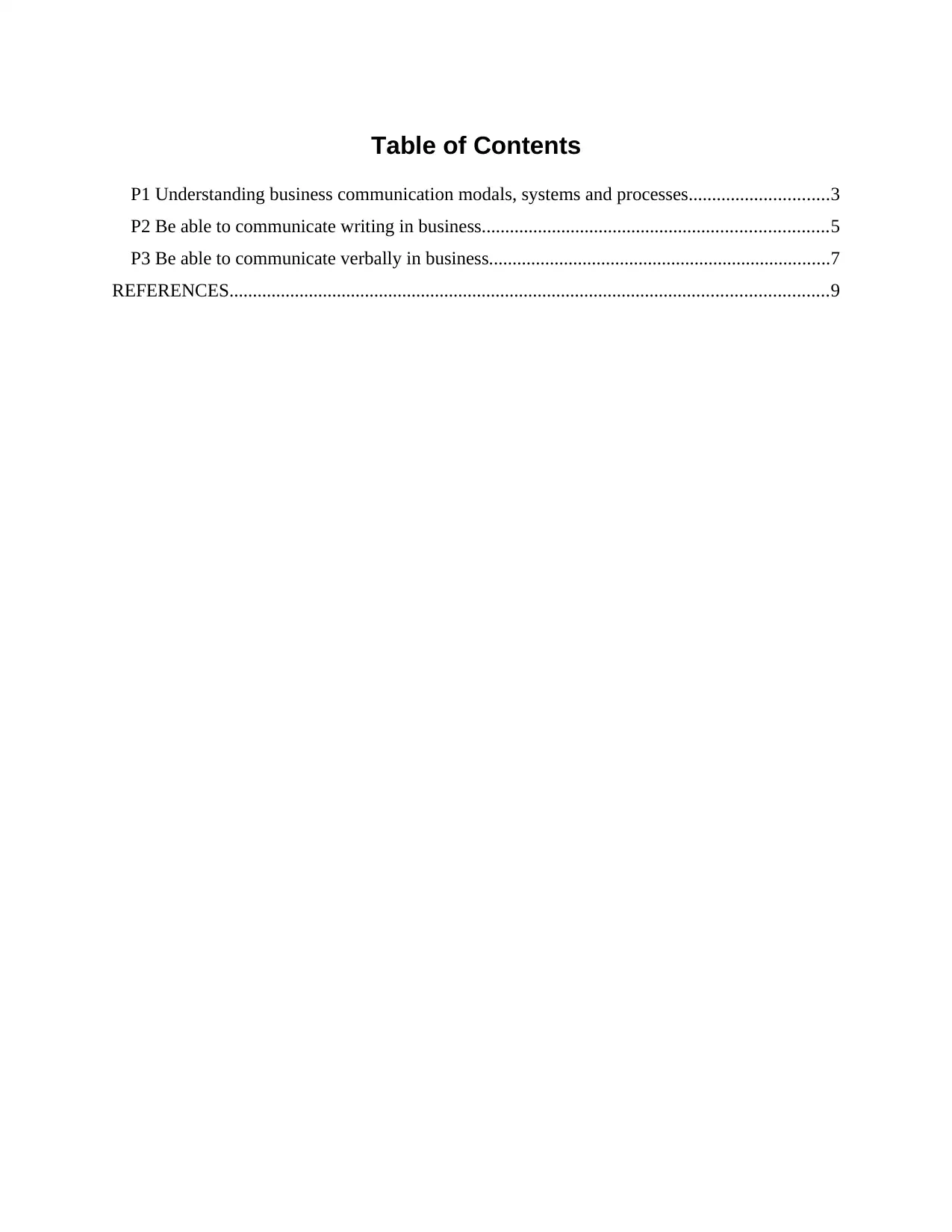
Table of Contents
P1 Understanding business communication modals, systems and processes..............................3
P2 Be able to communicate writing in business..........................................................................5
P3 Be able to communicate verbally in business.........................................................................7
REFERENCES................................................................................................................................9
P1 Understanding business communication modals, systems and processes..............................3
P2 Be able to communicate writing in business..........................................................................5
P3 Be able to communicate verbally in business.........................................................................7
REFERENCES................................................................................................................................9
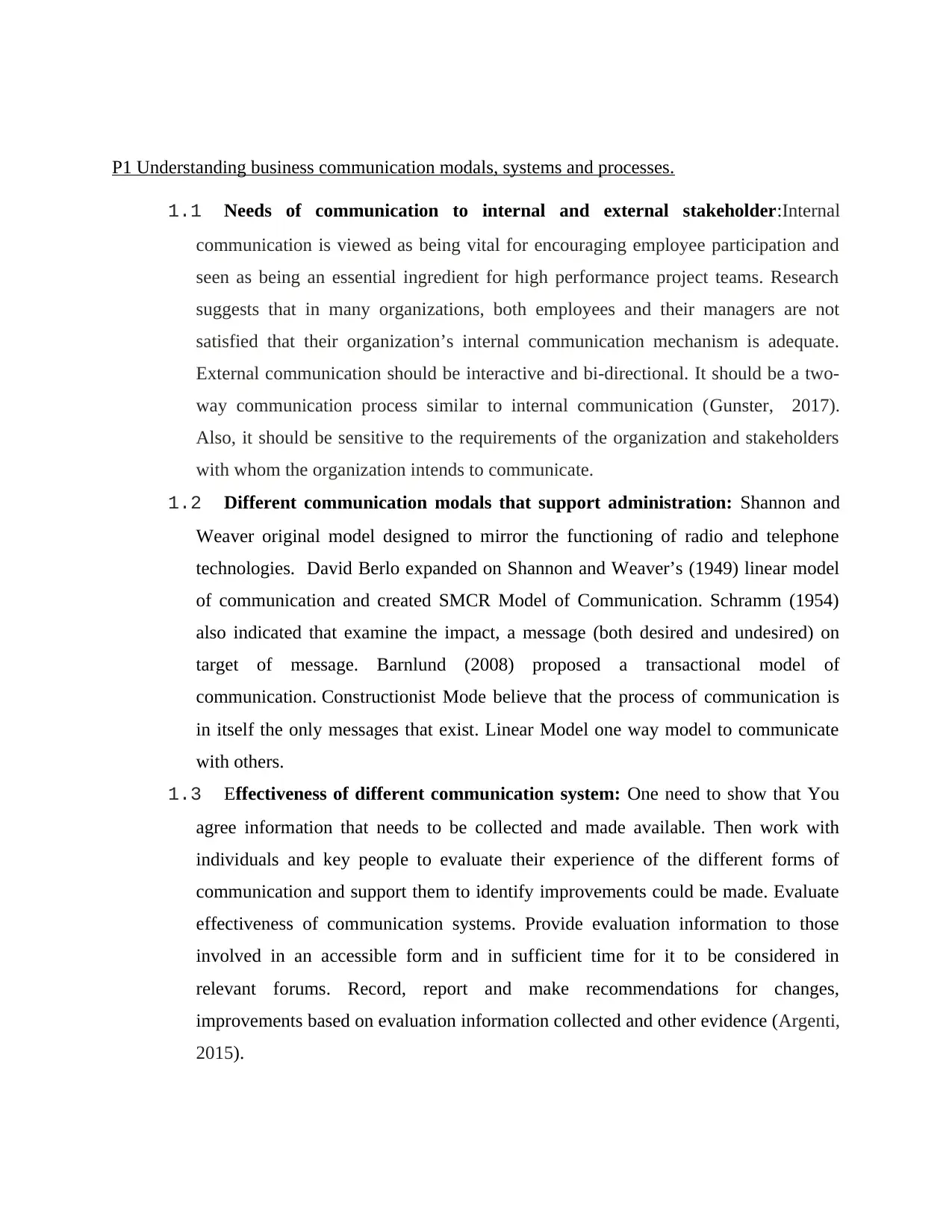
P1 Understanding business communication modals, systems and processes.
1.1 Needs of communication to internal and external stakeholder:Internal
communication is viewed as being vital for encouraging employee participation and
seen as being an essential ingredient for high performance project teams. Research
suggests that in many organizations, both employees and their managers are not
satisfied that their organization’s internal communication mechanism is adequate.
External communication should be interactive and bi-directional. It should be a two-
way communication process similar to internal communication (Gunster, 2017).
Also, it should be sensitive to the requirements of the organization and stakeholders
with whom the organization intends to communicate.
1.2 Different communication modals that support administration: Shannon and
Weaver original model designed to mirror the functioning of radio and telephone
technologies. David Berlo expanded on Shannon and Weaver’s (1949) linear model
of communication and created SMCR Model of Communication. Schramm (1954)
also indicated that examine the impact, a message (both desired and undesired) on
target of message. Barnlund (2008) proposed a transactional model of
communication. Constructionist Mode believe that the process of communication is
in itself the only messages that exist. Linear Model one way model to communicate
with others.
1.3 Effectiveness of different communication system: One need to show that You
agree information that needs to be collected and made available. Then work with
individuals and key people to evaluate their experience of the different forms of
communication and support them to identify improvements could be made. Evaluate
effectiveness of communication systems. Provide evaluation information to those
involved in an accessible form and in sufficient time for it to be considered in
relevant forums. Record, report and make recommendations for changes,
improvements based on evaluation information collected and other evidence (Argenti,
2015).
1.1 Needs of communication to internal and external stakeholder:Internal
communication is viewed as being vital for encouraging employee participation and
seen as being an essential ingredient for high performance project teams. Research
suggests that in many organizations, both employees and their managers are not
satisfied that their organization’s internal communication mechanism is adequate.
External communication should be interactive and bi-directional. It should be a two-
way communication process similar to internal communication (Gunster, 2017).
Also, it should be sensitive to the requirements of the organization and stakeholders
with whom the organization intends to communicate.
1.2 Different communication modals that support administration: Shannon and
Weaver original model designed to mirror the functioning of radio and telephone
technologies. David Berlo expanded on Shannon and Weaver’s (1949) linear model
of communication and created SMCR Model of Communication. Schramm (1954)
also indicated that examine the impact, a message (both desired and undesired) on
target of message. Barnlund (2008) proposed a transactional model of
communication. Constructionist Mode believe that the process of communication is
in itself the only messages that exist. Linear Model one way model to communicate
with others.
1.3 Effectiveness of different communication system: One need to show that You
agree information that needs to be collected and made available. Then work with
individuals and key people to evaluate their experience of the different forms of
communication and support them to identify improvements could be made. Evaluate
effectiveness of communication systems. Provide evaluation information to those
involved in an accessible form and in sufficient time for it to be considered in
relevant forums. Record, report and make recommendations for changes,
improvements based on evaluation information collected and other evidence (Argenti,
2015).
⊘ This is a preview!⊘
Do you want full access?
Subscribe today to unlock all pages.

Trusted by 1+ million students worldwide
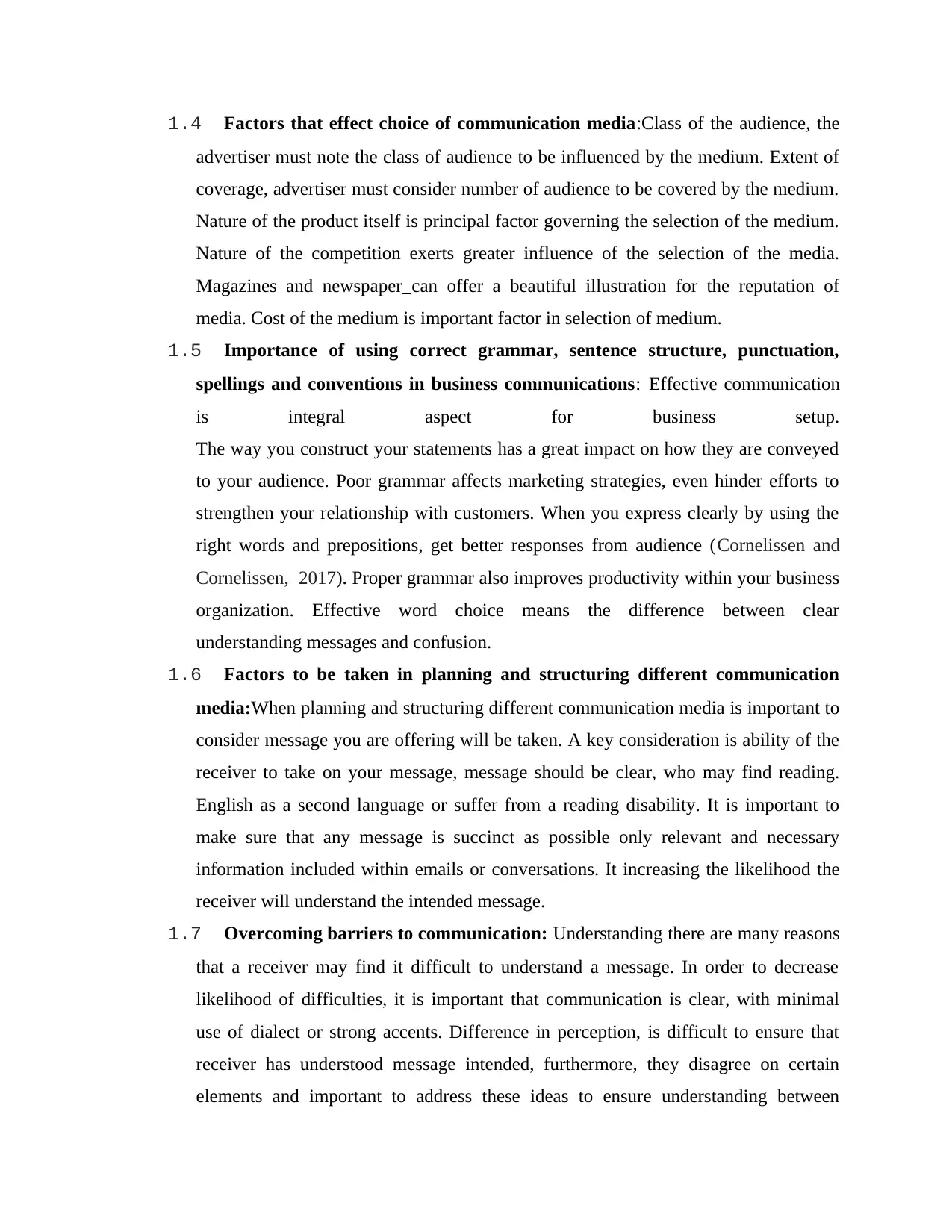
1.4 Factors that effect choice of communication media:Class of the audience, the
advertiser must note the class of audience to be influenced by the medium. Extent of
coverage, advertiser must consider number of audience to be covered by the medium.
Nature of the product itself is principal factor governing the selection of the medium.
Nature of the competition exerts greater influence of the selection of the media.
Magazines and newspaper can offer a beautiful illustration for the reputation of
media. Cost of the medium is important factor in selection of medium.
1.5 Importance of using correct grammar, sentence structure, punctuation,
spellings and conventions in business communications: Effective communication
is integral aspect for business setup.
The way you construct your statements has a great impact on how they are conveyed
to your audience. Poor grammar affects marketing strategies, even hinder efforts to
strengthen your relationship with customers. When you express clearly by using the
right words and prepositions, get better responses from audience (Cornelissen and
Cornelissen, 2017). Proper grammar also improves productivity within your business
organization. Effective word choice means the difference between clear
understanding messages and confusion.
1.6 Factors to be taken in planning and structuring different communication
media:When planning and structuring different communication media is important to
consider message you are offering will be taken. A key consideration is ability of the
receiver to take on your message, message should be clear, who may find reading.
English as a second language or suffer from a reading disability. It is important to
make sure that any message is succinct as possible only relevant and necessary
information included within emails or conversations. It increasing the likelihood the
receiver will understand the intended message.
1.7 Overcoming barriers to communication: Understanding there are many reasons
that a receiver may find it difficult to understand a message. In order to decrease
likelihood of difficulties, it is important that communication is clear, with minimal
use of dialect or strong accents. Difference in perception, is difficult to ensure that
receiver has understood message intended, furthermore, they disagree on certain
elements and important to address these ideas to ensure understanding between
advertiser must note the class of audience to be influenced by the medium. Extent of
coverage, advertiser must consider number of audience to be covered by the medium.
Nature of the product itself is principal factor governing the selection of the medium.
Nature of the competition exerts greater influence of the selection of the media.
Magazines and newspaper can offer a beautiful illustration for the reputation of
media. Cost of the medium is important factor in selection of medium.
1.5 Importance of using correct grammar, sentence structure, punctuation,
spellings and conventions in business communications: Effective communication
is integral aspect for business setup.
The way you construct your statements has a great impact on how they are conveyed
to your audience. Poor grammar affects marketing strategies, even hinder efforts to
strengthen your relationship with customers. When you express clearly by using the
right words and prepositions, get better responses from audience (Cornelissen and
Cornelissen, 2017). Proper grammar also improves productivity within your business
organization. Effective word choice means the difference between clear
understanding messages and confusion.
1.6 Factors to be taken in planning and structuring different communication
media:When planning and structuring different communication media is important to
consider message you are offering will be taken. A key consideration is ability of the
receiver to take on your message, message should be clear, who may find reading.
English as a second language or suffer from a reading disability. It is important to
make sure that any message is succinct as possible only relevant and necessary
information included within emails or conversations. It increasing the likelihood the
receiver will understand the intended message.
1.7 Overcoming barriers to communication: Understanding there are many reasons
that a receiver may find it difficult to understand a message. In order to decrease
likelihood of difficulties, it is important that communication is clear, with minimal
use of dialect or strong accents. Difference in perception, is difficult to ensure that
receiver has understood message intended, furthermore, they disagree on certain
elements and important to address these ideas to ensure understanding between
Paraphrase This Document
Need a fresh take? Get an instant paraphrase of this document with our AI Paraphraser
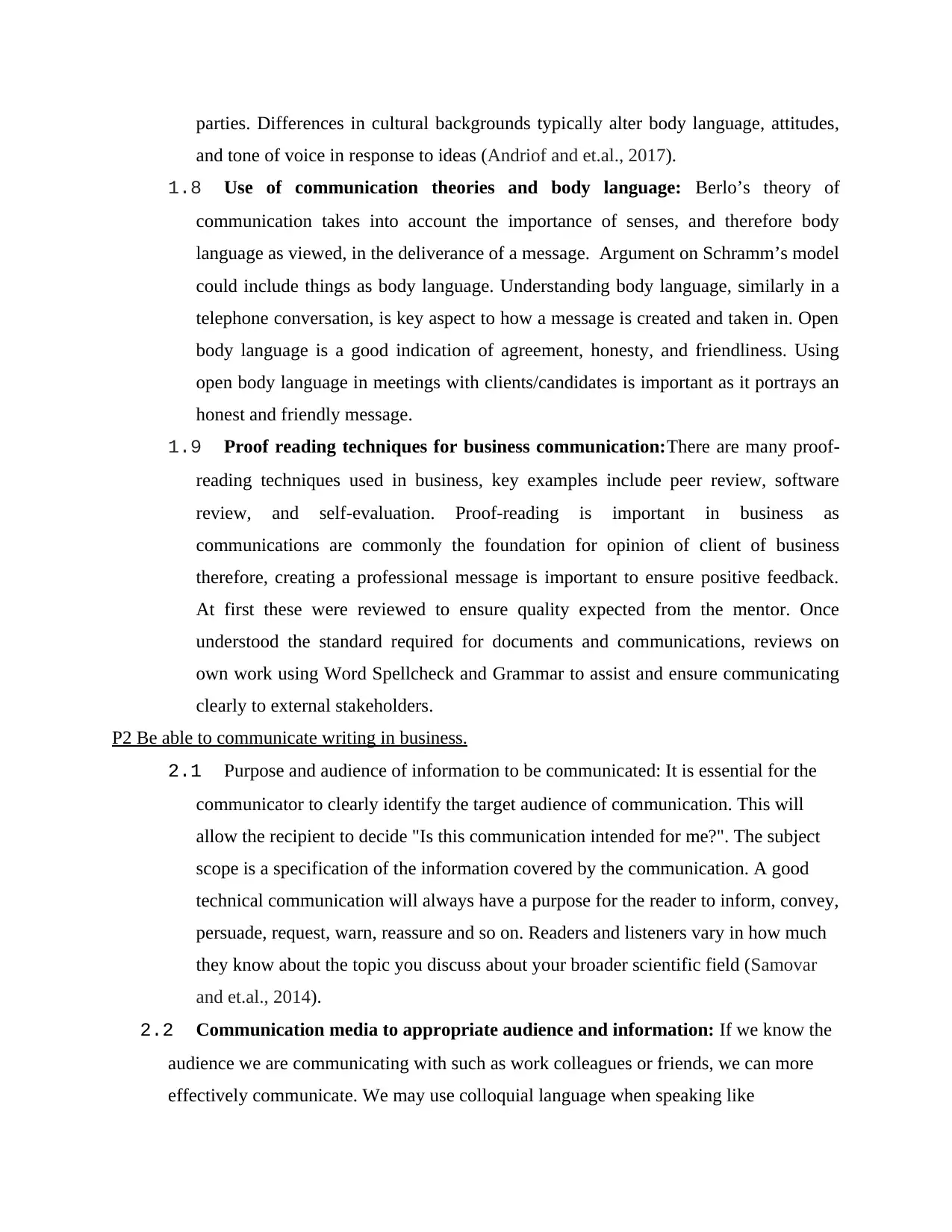
parties. Differences in cultural backgrounds typically alter body language, attitudes,
and tone of voice in response to ideas (Andriof and et.al., 2017).
1.8 Use of communication theories and body language: Berlo’s theory of
communication takes into account the importance of senses, and therefore body
language as viewed, in the deliverance of a message. Argument on Schramm’s model
could include things as body language. Understanding body language, similarly in a
telephone conversation, is key aspect to how a message is created and taken in. Open
body language is a good indication of agreement, honesty, and friendliness. Using
open body language in meetings with clients/candidates is important as it portrays an
honest and friendly message.
1.9 Proof reading techniques for business communication:There are many proof-
reading techniques used in business, key examples include peer review, software
review, and self-evaluation. Proof-reading is important in business as
communications are commonly the foundation for opinion of client of business
therefore, creating a professional message is important to ensure positive feedback.
At first these were reviewed to ensure quality expected from the mentor. Once
understood the standard required for documents and communications, reviews on
own work using Word Spellcheck and Grammar to assist and ensure communicating
clearly to external stakeholders.
P2 Be able to communicate writing in business.
2.1 Purpose and audience of information to be communicated: It is essential for the
communicator to clearly identify the target audience of communication. This will
allow the recipient to decide "Is this communication intended for me?". The subject
scope is a specification of the information covered by the communication. A good
technical communication will always have a purpose for the reader to inform, convey,
persuade, request, warn, reassure and so on. Readers and listeners vary in how much
they know about the topic you discuss about your broader scientific field (Samovar
and et.al., 2014).
2.2 Communication media to appropriate audience and information: If we know the
audience we are communicating with such as work colleagues or friends, we can more
effectively communicate. We may use colloquial language when speaking like
and tone of voice in response to ideas (Andriof and et.al., 2017).
1.8 Use of communication theories and body language: Berlo’s theory of
communication takes into account the importance of senses, and therefore body
language as viewed, in the deliverance of a message. Argument on Schramm’s model
could include things as body language. Understanding body language, similarly in a
telephone conversation, is key aspect to how a message is created and taken in. Open
body language is a good indication of agreement, honesty, and friendliness. Using
open body language in meetings with clients/candidates is important as it portrays an
honest and friendly message.
1.9 Proof reading techniques for business communication:There are many proof-
reading techniques used in business, key examples include peer review, software
review, and self-evaluation. Proof-reading is important in business as
communications are commonly the foundation for opinion of client of business
therefore, creating a professional message is important to ensure positive feedback.
At first these were reviewed to ensure quality expected from the mentor. Once
understood the standard required for documents and communications, reviews on
own work using Word Spellcheck and Grammar to assist and ensure communicating
clearly to external stakeholders.
P2 Be able to communicate writing in business.
2.1 Purpose and audience of information to be communicated: It is essential for the
communicator to clearly identify the target audience of communication. This will
allow the recipient to decide "Is this communication intended for me?". The subject
scope is a specification of the information covered by the communication. A good
technical communication will always have a purpose for the reader to inform, convey,
persuade, request, warn, reassure and so on. Readers and listeners vary in how much
they know about the topic you discuss about your broader scientific field (Samovar
and et.al., 2014).
2.2 Communication media to appropriate audience and information: If we know the
audience we are communicating with such as work colleagues or friends, we can more
effectively communicate. We may use colloquial language when speaking like
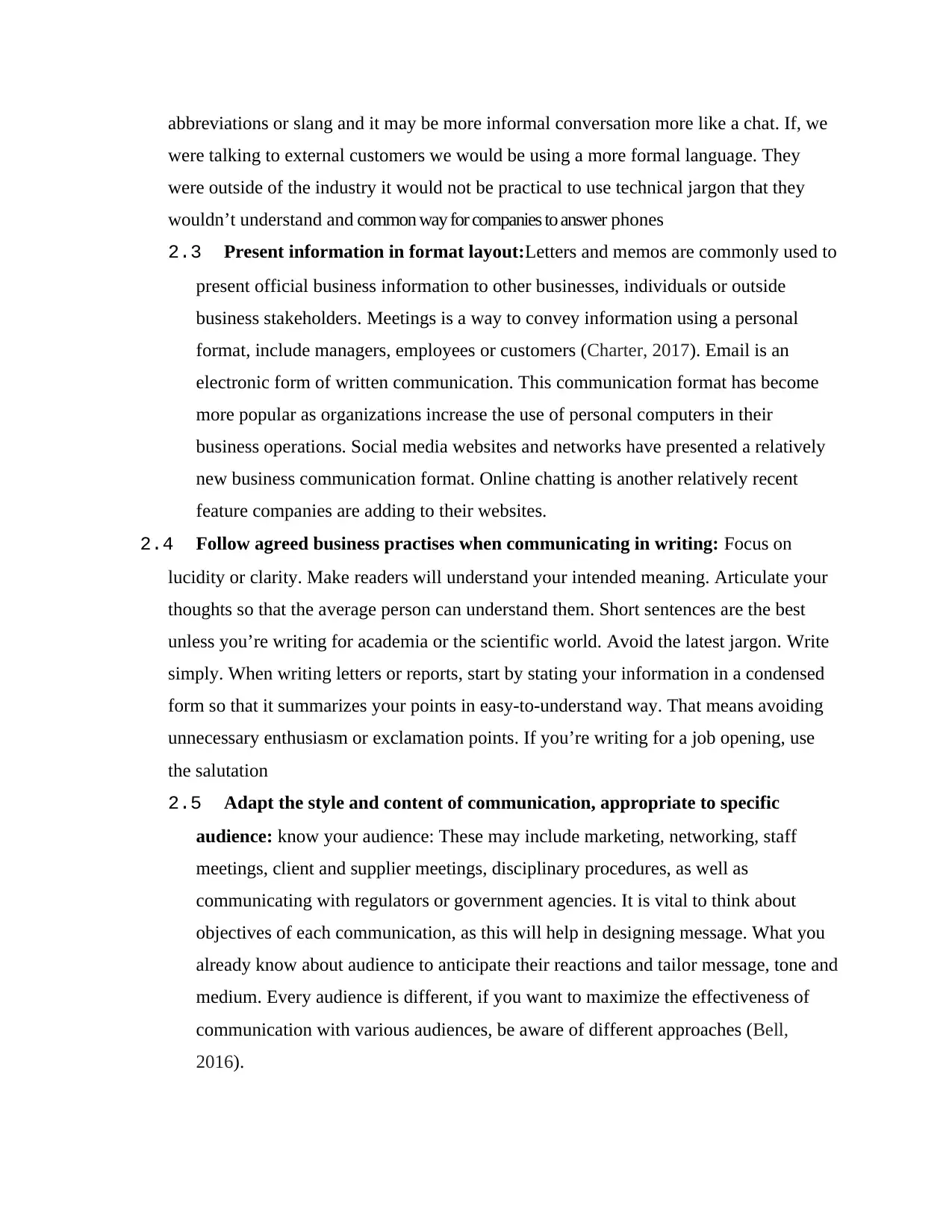
abbreviations or slang and it may be more informal conversation more like a chat. If, we
were talking to external customers we would be using a more formal language. They
were outside of the industry it would not be practical to use technical jargon that they
wouldn’t understand and common way for companies to answer phones
2.3 Present information in format layout:Letters and memos are commonly used to
present official business information to other businesses, individuals or outside
business stakeholders. Meetings is a way to convey information using a personal
format, include managers, employees or customers (Charter, 2017). Email is an
electronic form of written communication. This communication format has become
more popular as organizations increase the use of personal computers in their
business operations. Social media websites and networks have presented a relatively
new business communication format. Online chatting is another relatively recent
feature companies are adding to their websites.
2.4 Follow agreed business practises when communicating in writing: Focus on
lucidity or clarity. Make readers will understand your intended meaning. Articulate your
thoughts so that the average person can understand them. Short sentences are the best
unless you’re writing for academia or the scientific world. Avoid the latest jargon. Write
simply. When writing letters or reports, start by stating your information in a condensed
form so that it summarizes your points in easy-to-understand way. That means avoiding
unnecessary enthusiasm or exclamation points. If you’re writing for a job opening, use
the salutation
2.5 Adapt the style and content of communication, appropriate to specific
audience: know your audience: These may include marketing, networking, staff
meetings, client and supplier meetings, disciplinary procedures, as well as
communicating with regulators or government agencies. It is vital to think about
objectives of each communication, as this will help in designing message. What you
already know about audience to anticipate their reactions and tailor message, tone and
medium. Every audience is different, if you want to maximize the effectiveness of
communication with various audiences, be aware of different approaches (Bell,
2016).
were talking to external customers we would be using a more formal language. They
were outside of the industry it would not be practical to use technical jargon that they
wouldn’t understand and common way for companies to answer phones
2.3 Present information in format layout:Letters and memos are commonly used to
present official business information to other businesses, individuals or outside
business stakeholders. Meetings is a way to convey information using a personal
format, include managers, employees or customers (Charter, 2017). Email is an
electronic form of written communication. This communication format has become
more popular as organizations increase the use of personal computers in their
business operations. Social media websites and networks have presented a relatively
new business communication format. Online chatting is another relatively recent
feature companies are adding to their websites.
2.4 Follow agreed business practises when communicating in writing: Focus on
lucidity or clarity. Make readers will understand your intended meaning. Articulate your
thoughts so that the average person can understand them. Short sentences are the best
unless you’re writing for academia or the scientific world. Avoid the latest jargon. Write
simply. When writing letters or reports, start by stating your information in a condensed
form so that it summarizes your points in easy-to-understand way. That means avoiding
unnecessary enthusiasm or exclamation points. If you’re writing for a job opening, use
the salutation
2.5 Adapt the style and content of communication, appropriate to specific
audience: know your audience: These may include marketing, networking, staff
meetings, client and supplier meetings, disciplinary procedures, as well as
communicating with regulators or government agencies. It is vital to think about
objectives of each communication, as this will help in designing message. What you
already know about audience to anticipate their reactions and tailor message, tone and
medium. Every audience is different, if you want to maximize the effectiveness of
communication with various audiences, be aware of different approaches (Bell,
2016).
⊘ This is a preview!⊘
Do you want full access?
Subscribe today to unlock all pages.

Trusted by 1+ million students worldwide
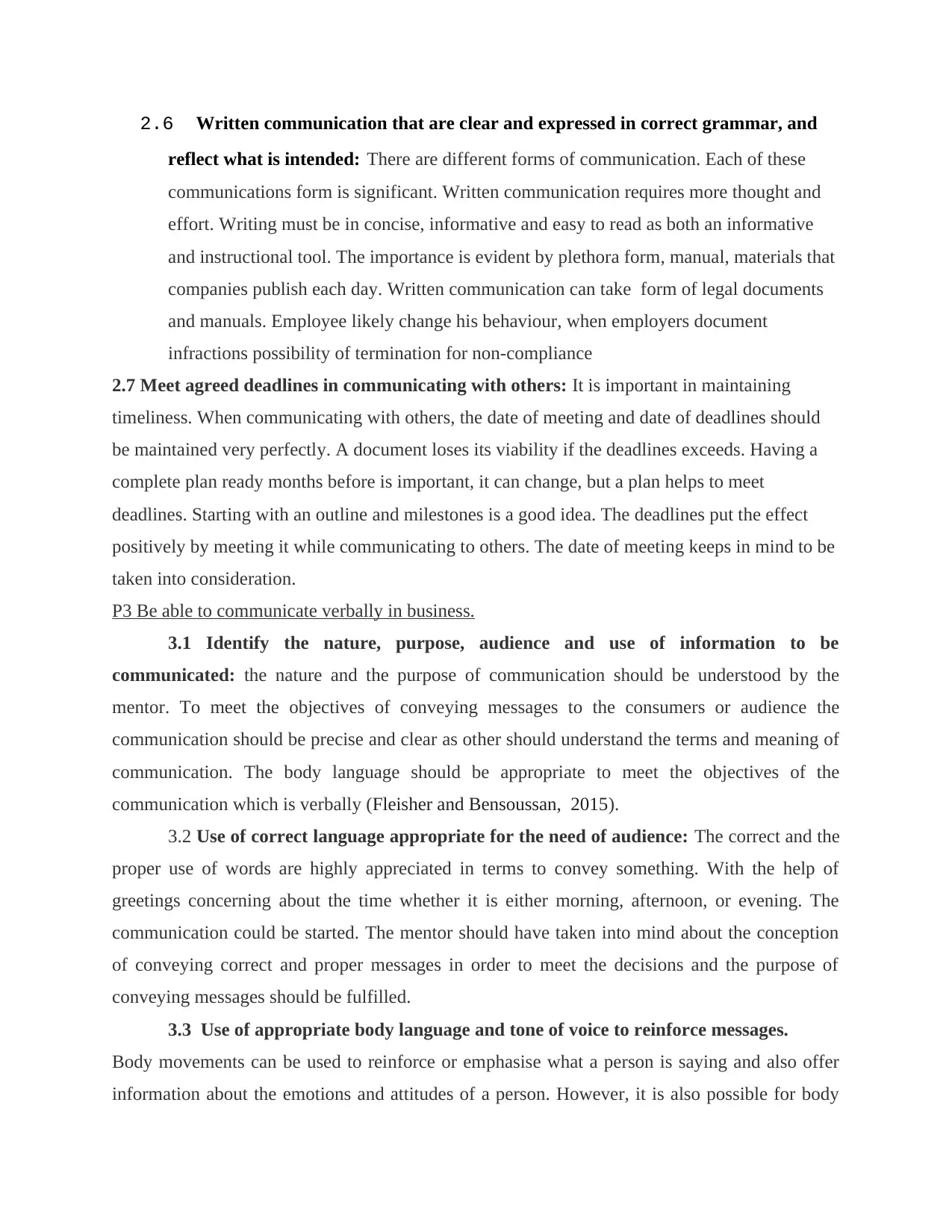
2.6 Written communication that are clear and expressed in correct grammar, and
reflect what is intended: There are different forms of communication. Each of these
communications form is significant. Written communication requires more thought and
effort. Writing must be in concise, informative and easy to read as both an informative
and instructional tool. The importance is evident by plethora form, manual, materials that
companies publish each day. Written communication can take form of legal documents
and manuals. Employee likely change his behaviour, when employers document
infractions possibility of termination for non-compliance
2.7 Meet agreed deadlines in communicating with others: It is important in maintaining
timeliness. When communicating with others, the date of meeting and date of deadlines should
be maintained very perfectly. A document loses its viability if the deadlines exceeds. Having a
complete plan ready months before is important, it can change, but a plan helps to meet
deadlines. Starting with an outline and milestones is a good idea. The deadlines put the effect
positively by meeting it while communicating to others. The date of meeting keeps in mind to be
taken into consideration.
P3 Be able to communicate verbally in business.
3.1 Identify the nature, purpose, audience and use of information to be
communicated: the nature and the purpose of communication should be understood by the
mentor. To meet the objectives of conveying messages to the consumers or audience the
communication should be precise and clear as other should understand the terms and meaning of
communication. The body language should be appropriate to meet the objectives of the
communication which is verbally (Fleisher and Bensoussan, 2015).
3.2 Use of correct language appropriate for the need of audience: The correct and the
proper use of words are highly appreciated in terms to convey something. With the help of
greetings concerning about the time whether it is either morning, afternoon, or evening. The
communication could be started. The mentor should have taken into mind about the conception
of conveying correct and proper messages in order to meet the decisions and the purpose of
conveying messages should be fulfilled.
3.3 Use of appropriate body language and tone of voice to reinforce messages.
Body movements can be used to reinforce or emphasise what a person is saying and also offer
information about the emotions and attitudes of a person. However, it is also possible for body
reflect what is intended: There are different forms of communication. Each of these
communications form is significant. Written communication requires more thought and
effort. Writing must be in concise, informative and easy to read as both an informative
and instructional tool. The importance is evident by plethora form, manual, materials that
companies publish each day. Written communication can take form of legal documents
and manuals. Employee likely change his behaviour, when employers document
infractions possibility of termination for non-compliance
2.7 Meet agreed deadlines in communicating with others: It is important in maintaining
timeliness. When communicating with others, the date of meeting and date of deadlines should
be maintained very perfectly. A document loses its viability if the deadlines exceeds. Having a
complete plan ready months before is important, it can change, but a plan helps to meet
deadlines. Starting with an outline and milestones is a good idea. The deadlines put the effect
positively by meeting it while communicating to others. The date of meeting keeps in mind to be
taken into consideration.
P3 Be able to communicate verbally in business.
3.1 Identify the nature, purpose, audience and use of information to be
communicated: the nature and the purpose of communication should be understood by the
mentor. To meet the objectives of conveying messages to the consumers or audience the
communication should be precise and clear as other should understand the terms and meaning of
communication. The body language should be appropriate to meet the objectives of the
communication which is verbally (Fleisher and Bensoussan, 2015).
3.2 Use of correct language appropriate for the need of audience: The correct and the
proper use of words are highly appreciated in terms to convey something. With the help of
greetings concerning about the time whether it is either morning, afternoon, or evening. The
communication could be started. The mentor should have taken into mind about the conception
of conveying correct and proper messages in order to meet the decisions and the purpose of
conveying messages should be fulfilled.
3.3 Use of appropriate body language and tone of voice to reinforce messages.
Body movements can be used to reinforce or emphasise what a person is saying and also offer
information about the emotions and attitudes of a person. However, it is also possible for body
Paraphrase This Document
Need a fresh take? Get an instant paraphrase of this document with our AI Paraphraser
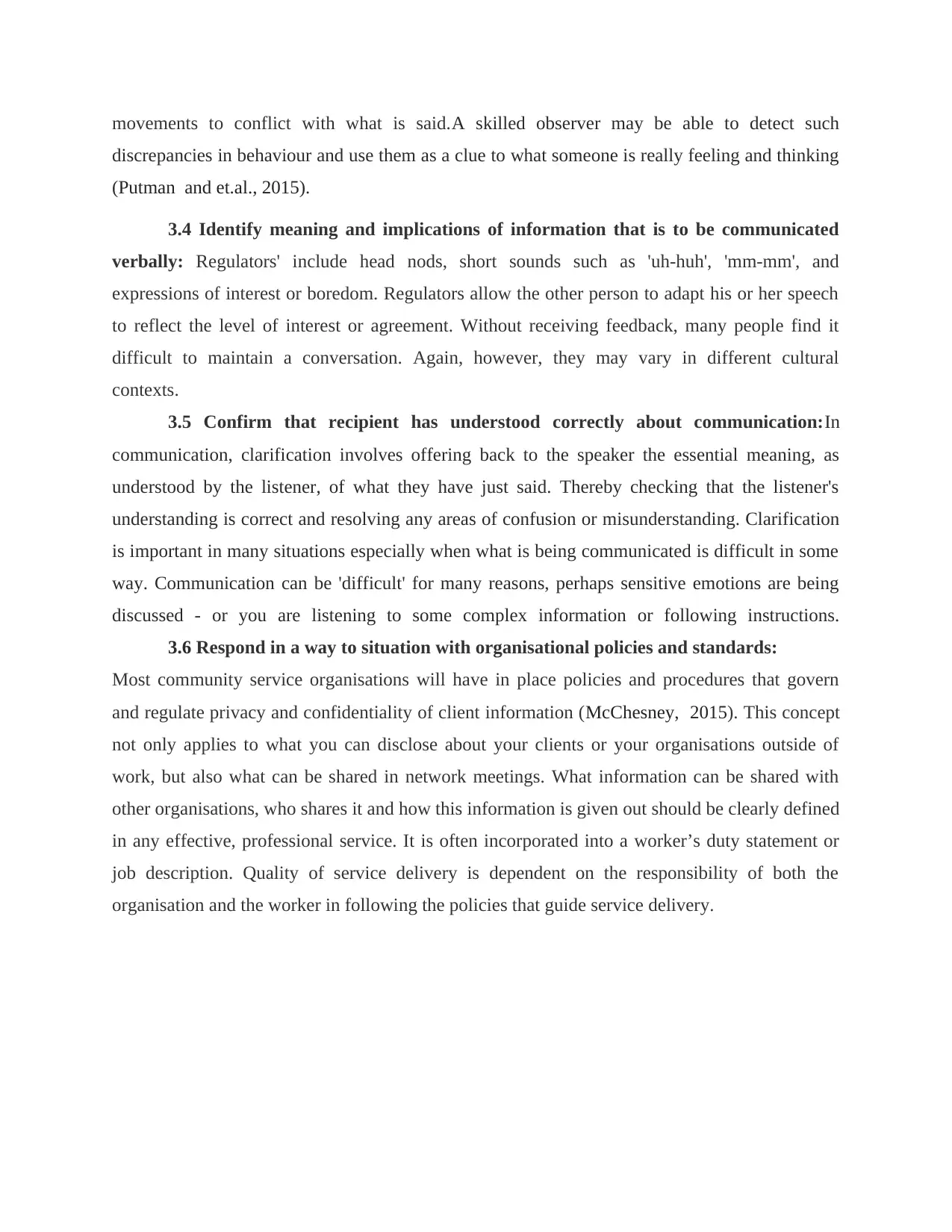
movements to conflict with what is said.A skilled observer may be able to detect such
discrepancies in behaviour and use them as a clue to what someone is really feeling and thinking
(Putman and et.al., 2015).
3.4 Identify meaning and implications of information that is to be communicated
verbally: Regulators' include head nods, short sounds such as 'uh-huh', 'mm-mm', and
expressions of interest or boredom. Regulators allow the other person to adapt his or her speech
to reflect the level of interest or agreement. Without receiving feedback, many people find it
difficult to maintain a conversation. Again, however, they may vary in different cultural
contexts.
3.5 Confirm that recipient has understood correctly about communication:In
communication, clarification involves offering back to the speaker the essential meaning, as
understood by the listener, of what they have just said. Thereby checking that the listener's
understanding is correct and resolving any areas of confusion or misunderstanding. Clarification
is important in many situations especially when what is being communicated is difficult in some
way. Communication can be 'difficult' for many reasons, perhaps sensitive emotions are being
discussed - or you are listening to some complex information or following instructions.
3.6 Respond in a way to situation with organisational policies and standards:
Most community service organisations will have in place policies and procedures that govern
and regulate privacy and confidentiality of client information (McChesney, 2015). This concept
not only applies to what you can disclose about your clients or your organisations outside of
work, but also what can be shared in network meetings. What information can be shared with
other organisations, who shares it and how this information is given out should be clearly defined
in any effective, professional service. It is often incorporated into a worker’s duty statement or
job description. Quality of service delivery is dependent on the responsibility of both the
organisation and the worker in following the policies that guide service delivery.
discrepancies in behaviour and use them as a clue to what someone is really feeling and thinking
(Putman and et.al., 2015).
3.4 Identify meaning and implications of information that is to be communicated
verbally: Regulators' include head nods, short sounds such as 'uh-huh', 'mm-mm', and
expressions of interest or boredom. Regulators allow the other person to adapt his or her speech
to reflect the level of interest or agreement. Without receiving feedback, many people find it
difficult to maintain a conversation. Again, however, they may vary in different cultural
contexts.
3.5 Confirm that recipient has understood correctly about communication:In
communication, clarification involves offering back to the speaker the essential meaning, as
understood by the listener, of what they have just said. Thereby checking that the listener's
understanding is correct and resolving any areas of confusion or misunderstanding. Clarification
is important in many situations especially when what is being communicated is difficult in some
way. Communication can be 'difficult' for many reasons, perhaps sensitive emotions are being
discussed - or you are listening to some complex information or following instructions.
3.6 Respond in a way to situation with organisational policies and standards:
Most community service organisations will have in place policies and procedures that govern
and regulate privacy and confidentiality of client information (McChesney, 2015). This concept
not only applies to what you can disclose about your clients or your organisations outside of
work, but also what can be shared in network meetings. What information can be shared with
other organisations, who shares it and how this information is given out should be clearly defined
in any effective, professional service. It is often incorporated into a worker’s duty statement or
job description. Quality of service delivery is dependent on the responsibility of both the
organisation and the worker in following the policies that guide service delivery.
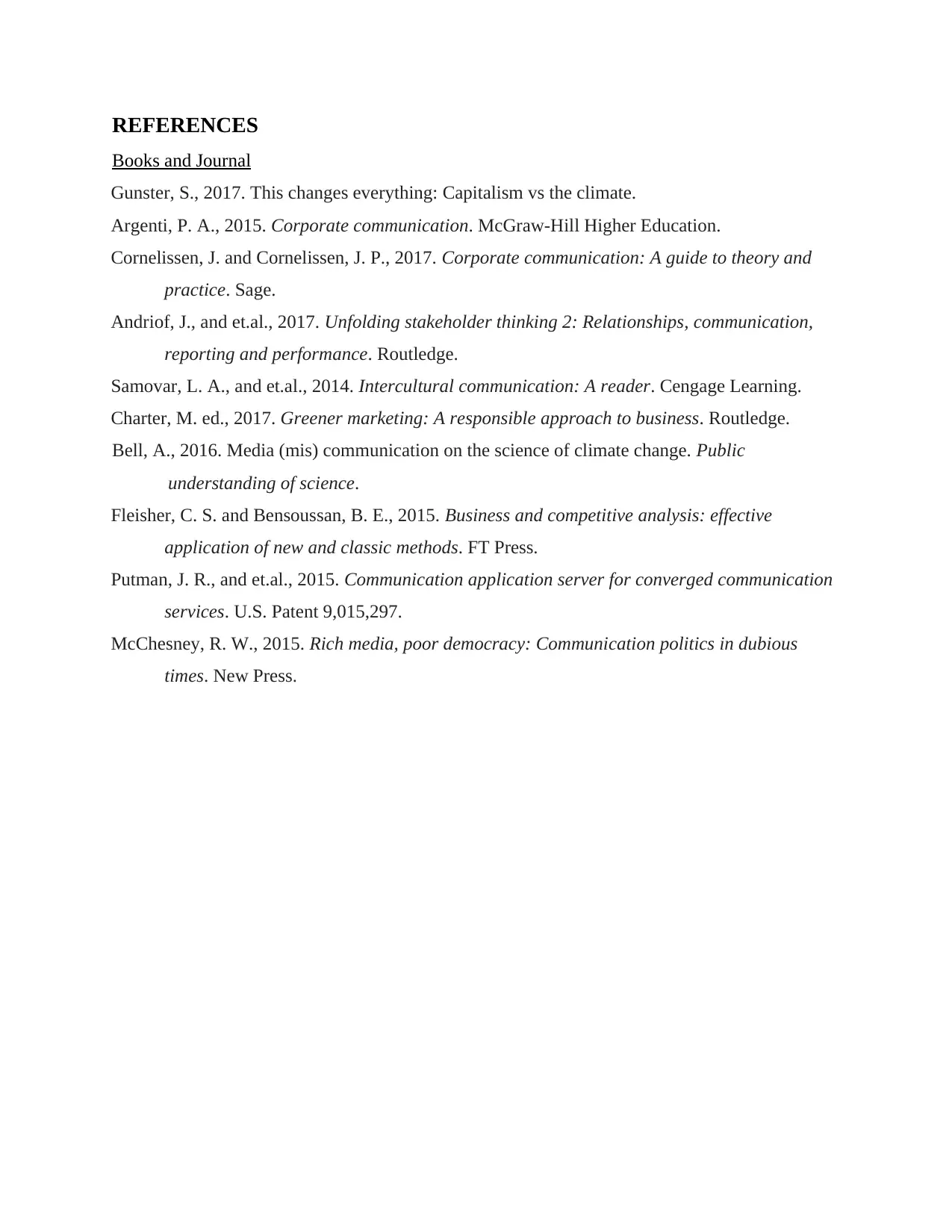
REFERENCES
Books and Journal
Gunster, S., 2017. This changes everything: Capitalism vs the climate.
Argenti, P. A., 2015. Corporate communication. McGraw-Hill Higher Education.
Cornelissen, J. and Cornelissen, J. P., 2017. Corporate communication: A guide to theory and
practice. Sage.
Andriof, J., and et.al., 2017. Unfolding stakeholder thinking 2: Relationships, communication,
reporting and performance. Routledge.
Samovar, L. A., and et.al., 2014. Intercultural communication: A reader. Cengage Learning.
Charter, M. ed., 2017. Greener marketing: A responsible approach to business. Routledge.
Bell, A., 2016. Media (mis) communication on the science of climate change. Public
understanding of science.
Fleisher, C. S. and Bensoussan, B. E., 2015. Business and competitive analysis: effective
application of new and classic methods. FT Press.
Putman, J. R., and et.al., 2015. Communication application server for converged communication
services. U.S. Patent 9,015,297.
McChesney, R. W., 2015. Rich media, poor democracy: Communication politics in dubious
times. New Press.
Books and Journal
Gunster, S., 2017. This changes everything: Capitalism vs the climate.
Argenti, P. A., 2015. Corporate communication. McGraw-Hill Higher Education.
Cornelissen, J. and Cornelissen, J. P., 2017. Corporate communication: A guide to theory and
practice. Sage.
Andriof, J., and et.al., 2017. Unfolding stakeholder thinking 2: Relationships, communication,
reporting and performance. Routledge.
Samovar, L. A., and et.al., 2014. Intercultural communication: A reader. Cengage Learning.
Charter, M. ed., 2017. Greener marketing: A responsible approach to business. Routledge.
Bell, A., 2016. Media (mis) communication on the science of climate change. Public
understanding of science.
Fleisher, C. S. and Bensoussan, B. E., 2015. Business and competitive analysis: effective
application of new and classic methods. FT Press.
Putman, J. R., and et.al., 2015. Communication application server for converged communication
services. U.S. Patent 9,015,297.
McChesney, R. W., 2015. Rich media, poor democracy: Communication politics in dubious
times. New Press.
⊘ This is a preview!⊘
Do you want full access?
Subscribe today to unlock all pages.

Trusted by 1+ million students worldwide
1 out of 9
Related Documents
Your All-in-One AI-Powered Toolkit for Academic Success.
+13062052269
info@desklib.com
Available 24*7 on WhatsApp / Email
![[object Object]](/_next/static/media/star-bottom.7253800d.svg)
Unlock your academic potential
Copyright © 2020–2025 A2Z Services. All Rights Reserved. Developed and managed by ZUCOL.




